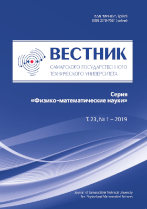|
Mathematical Modeling, Numerical Methods and Software Complexes
Comparison of the orbital elements of major planets, the Moon and the Sun using various mathematical models on the time interval with 1600 to 2200
A. F. Zausaev, M. A. Romanyuk
Samara State Technical University, Samara, 443100, Russian Federation
(published under the terms of the Creative Commons Attribution 4.0 International License)
Abstract:
An analysis of the accuracy of the orbital elements obtained according to the coordinates and components of the velocities, found using the coefficients of the Chebyshev polynomials of the DE405 planetary catalog, is carried out. We compared the elements of orbital elements in the time interval from 1600 to 2200 years found using the DE405 catalog and obtained by numerical integration of the equations of motion based on the interaction of moving material bodies with the surrounding space. On the example of the numerical integration of the Moon motion equations, the advantage of using the equations of motion based on the interaction of moving material bodies with the surrounding space is shown in comparison with relativistic equations. Based on a comparison of the elements of Mercury's orbits, found by coordinates obtained by solving equations based on the interaction of moving material bodies with the surrounding space, and obtained using the DE405 catalog, it is shown that the orbital elements practically coincide on a given interval time. The maximum discrepancy in the mean anomaly at the end of the integration interval is less than $1''$ (second). The discrepancies of the secular displacements of perihelions for Mercury, Venus, Earth + Moon and Mars were determined, the values of which for DE405 are respectively: $43.08''$, $8.4''$, $3.83''$ and $1.14''$.
It is shown that the errors of the secular displacements of the perihelions of the planets Mercury, Venus, the barycenter of the Earth + Moon and Mars obtained using the DE405 catalog take the following values: $0''$, $6.06''$, $3.83''$ and $1.08''$. For the outer planets: Jupiter, Saturn, Uranus, Neptune and the dwarf planet Pluto, on the basis of the considered comparisons of various equations of motion, no discrepancies in the orbital elements were found. Based on the studies carried out, it is shown that the use of harmonic coordinates in relativistic equations when creating the DE405 catalog is justified only for Mercury and the outer planets: Jupiter, Saturn, Uranus, Neptune and the dwarf planet Pluto.
Keywords:
orbital elements, numerical integration, differential equation of motion.
Received: October 19, 2021
Revised: October 15, 2022
Accepted: November 17, 2022
First online: December 6, 2022
Citation:
A. F. Zausaev, M. A. Romanyuk, “Comparison of the orbital elements of major planets, the Moon and the Sun using various mathematical models on the time interval with 1600 to 2200”, Vestn. Samar. Gos. Tekhn. Univ., Ser. Fiz.-Mat. Nauki [J. Samara State Tech. Univ., Ser. Phys. Math. Sci.], 26:4 (2022), 738–763
Linking options:
https://www.mathnet.ru/eng/vsgtu1888 https://www.mathnet.ru/eng/vsgtu/v226/i4/p738
|

|




 Contact us:
Contact us: Terms of Use
Terms of Use
 Registration to the website
Registration to the website Logotypes
Logotypes









 Citation in format
Citation in format 